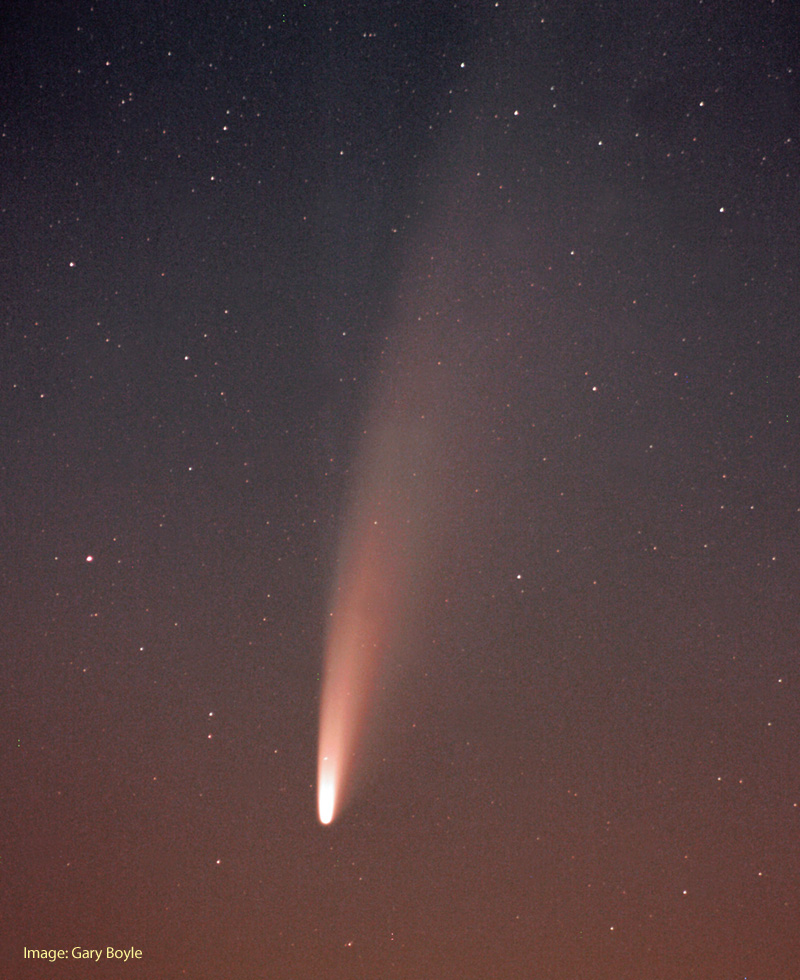Comet NEOWISE
A few months ago we had expectations of seeing Comet Atlas at naked-eye status and possibility the best comet to appear in two decades but it disintegrated into some thirty pieces as seen by Hubble. Then Comet Swan was given a fantastic show in the southern United States and was moving north to Canadian skies. Along the way, it had a dramatic brightening which ultimately led to the comet’s demise as it met its fate and disappeared, but third time a charm. Comet C/2020 F3 (NEOWISE) has been a fantastic object in the early morning pre-dawn sky and is now moving to the early evening sky. It will be well placed below the Big Dipper to see and photograph over the next couple of weeks and hopefully into August. I have been following and imaging this comet since the first week of July and could see it even without binoculars (naked eye).
The comet was discovered on March 27, 2020, by the Near Earth Object Wide-field Infrared Survey Explorer space telescope as it looks for near-earth objects that could come close or even potentially impact our planet. Measuring a little more than half the height of Mount Everest, this object falls into the category of a “once in a decade comet”.
Every year astronomers both amateur and professional observe 5 to 10 comets with telescopes. In most cases, they show a green nucleus from the sublimation of frozen chemicals such as ammonia and others. The extremely faint tail is seen when photographed but all comets are different in composition and appearance as Neowise does not appear green. The last bright comet that was visible to the naked eye for the whole world to see was Comet Hale-Bopp in 1997. And like Neowise, it too had a blue ion or gas tail and a fan-shaped dust tail created when comets round the sun as this one did on July 3 at a close distance of 43 million kilometres.

Neowise will be closest to earth on its way out of the solar system on July 22 at a safe distance of 103 million kilometres and will be starting to fade with a shortening tail as it retreats from the sun's heat and back to the icy depths of space. Comet Neowise originates from the Oort Cloud, where long-period comets reside and will return close to 6,800 years from now. Halley’s Comet is a short period comet originating from the Kuiper Belt. Along with this chart of the comet’s path, many smartphone astronomy apps will also guide you to our celestial visitor.
The comet is also a very easy target to image with a DSLR camera on a tripod and a cable release or an intervalometer. Set your camera to a high ISO such as 3200 and you will be surprised what you will capture in just a few seconds. Enjoy this spectacular comet every chance you can as you never know when the next bright will come to visit.
As the sun sets, look for the brilliant planet Jupiter in the southeast as it achieves opposition on the 14 with fainter Saturn to the left rising shortly after and also achieves opposition on the 20. Both planets will be out all night long and set at sunrise. Mars is steadily getting brighter as our distance with the red planet continues to shorten. Mars will be closest to earth on October 6 and opposition on the 13th. Venus is now in the eastern sky into the Hyades cluster and close to Aldebaran or the angry eye of the bull.
The new moon occurs on July 20 so we should have moon free nights to image the comet.
Until next month, clear skies everyone.
